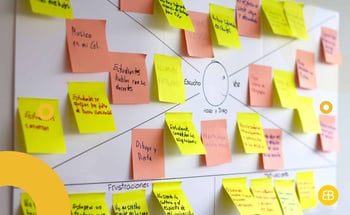Table of Contents
When it comes to planning for your next project, you’ve covered time management and financial management, but have you developed a complete scope management plan?
If you’re not sure what scoping means, don’t worry, you’re in the right place. We’ve got you covered with everything you need to know about defining the scope of your project and how to do it.
So, if you’re tired of going over budget and overtime on every project, then keep reading to learn all you need about scoping.
What Is Scoping?
As you plan your next project, you can’t ignore the very important aspect of scope. Defining the scope of your project not only gives you and your team very clear boundaries within which to work, but also ensures that your clients understand what their final deliverable will contain as well.
Every project manager understands that sinking feeling when a client comes back to you with a delivered product and asks for something else. It’s fine if you truly didn’t deliver on part of the project. But it can become burdensome and costly when clients continually move the goal line for every project.
This phenomenon has not-so-lovingly been referred to as scope-creep when projects balloon to sizes you didn’t plan for or budget properly for. This can blow your timeline and budget quickly as well as leaving you and your client with a less than satisfying feeling at the end of the project.
Why Is Scoping Important?
Clients don’t always mean to get more than they pay for. But sometimes they don’t know what they want until they see the final product and realize that it isn’t what they wanted. By incorporating scoping into your planning phase of every project, you can avoid this frustrating and inevitable situation.
Instead, you can create a product vision that shows your clients what they will receive at the end of the contract. Additionally, you can prepare them with milestones and continual communication along the way.
When it comes to app development, scoping and milestones can save everyone a lot of time, money, and frustration. So, now you know what it is and why you need it, let’s jump into the seven simple steps you need to follow to establish project scope every time.
7 Steps to Defining Your Project Scope
You wouldn’t start running a marathon without first establishing the route you will take and where the finish line is. This is the point in your planning phase where you will do just that.
1. Start With the End in Mind
The first step in defining your scope is to define a clearly established finish line. This gives both the developer or designer and the client a clear idea of what everyone can expect at the end of the project.
You need to take the time to sit down as a team and establish well-defined objectives and goals for your project. Are you developing an app for a client? Then you need to establish not only the platform they want it to run on but also what the final goals will be for the app.
Will it keep current clients up-to-date on new launches and sales? Or will it be better used for customer service? Establish this now so you don’t have any surprises on delivery day.
2. List Your Stakeholders
A general description of the stakeholders in your project is anyone actively involved in the project. Obviously, this list can become quite long. But if you want to define the scope and keep everyone in line with the end goal, then you need to keep everyone on the same page.
This step can be easy to skip. But without it, you can find yourself unaware that your client has their own graphic designer that they will insist on using mid-project. And further, that their graphic designer didn’t adequately clear their schedule because they hadn’t been looped into the communication on this project.
Don’t let that happen to you. Take the time now to list out the stakeholders for this project. Some of the usual suspects are obviously the project manager and the client.
After that, it can become unclear who needs to be a vested stakeholder in this project. Ask yourself the following questions to start brainstorming:
- Who will design the product?
- Who will market the product?
- Who will supply the raw materials for the product?
- Who will finance the project? And, how much are they expecting to finance compared to how much will be required?
Now you have a better idea of who to loop into the communication throughout the project so that everyone is on the same page and your scope doesn’t creep out of bounds.
3. Determine the Needs of Your Stakeholders
As we established, your stakeholders can be anyone within your company needing this finalized project. Or, it can be a client who has ordered a specific deliverable product. Either way, you need to take the time to interview your stakeholders as you define the scope of your project.
This step can be time-consuming if you’re working with co-workers who are especially busy and don’t think they have the time to discuss the scope of the project they’ve just requested of you. But save your team the headaches and hassles that will come mid-project when the stakeholder comes back to you to say that you’re off-course.
Some questions to ask the stakeholders at this point include their required features or specifications. Additionally, ask for their timeline and budget restrictions. The answers to these questions will determine how you finalize the scope of the project in later steps.
In addition to finding out what your stakeholders need from you, you can also share with them what you need from them. For your clients, this can mean outlining communication guidelines and expectations. This will help avoid midnight or weekend emails that they expect to be answered right away.
So, while this step can seem time-consuming and bothersome, it will save you time and money later on. By speaking with each of your stakeholders in advance you can avoid that inevitable conversation that will come when their expectations weren’t met because they weren’t outlined in the beginning.
4. Determine the Resources Needed
Your list of resources can be just as long as your list of stakeholders. Think beyond time and finances. Take the time now to determine exactly what you will need to complete the project on time and under the budget so that you can also begin determining where each resource will come from.
Think about who will complete each step. Internal staff can be a great resource when you need them to help complete a crucial step in your project. However, if you don’t outline when you will need them and how many hours you will need them for, you will find yourself at the bottom of their to-do list right when you need them most.
Additionally, determine what raw materials will be needed for your project. Where will you get them from and will your supplier have what you need when you need it? Don’t find yourself at the bad end of a logistics nightmare trying to overnight a substitute item because you didn’t plan ahead.
Lastly, will you need to outsource any part of the project to a freelancer or agency? When you work with an agency you can cut your deliverable time considerably. Use the expertise of an agency to deliver amazing products to your clients without needing to hire anyone internally or learn how to do it yourself.
5. List Any Limitations or Obstacles
What time or budgetary constraints will you have during your project? Determine this now so you don’t find yourself floundering mid-project when the client decides they also need their new app to have a chatbot feature. Do you have the technological capacity to ensure that their needs are met every time?
As you define the scope, you will need to know what limitations the client may want to implement on this project. Will they want to run on iOS or Android? Or are they interested in a web app?
Know your limitations and obstacles in the beginning so you can plan how you will handle them when the time comes.
6. Map Out a Preliminary Schedule
This is your roadmap that your team will follow as they complete the project. Whether you’re creating a new product or improving a current system or process within your own organization, every project will need a preliminary schedule to follow.
To create this roadmap you will need the information gathered in the previous steps. This is where it is important to know the exact deliverable expectations of your client. And this is where it’s important to know the financial resources needed from your suppliers and team members. So, gather the information in the previous steps and then take the necessary time to plan your project schedule.
There are many tools you can use to create your timeline for the completion of your project. So, whether you decide to go digital or stick to sticky notes on a whiteboard, the main key to remember is that you establish clear milestones and then communicate them to your team and stakeholders regularly.
When everyone knows what to expect and when you won’t find yourself with unhappy clients or stressed-out team members. So, take the time now to create an outline or roadmap everyone can follow as you work towards the completion of your project.
7. Continue to Communicate With Your Client
This last step will be an on-going part of your project. Now that you’ve taken the time to complete the steps in outlining a clear scope for your project, take the time to keep the lines of communication open with everyone involved.
Work with your clients to determine their best communication platform. Also, loop them into any project management software program you might be using so they’re updating as each milestone is reached.
Communicating with clients will mean fewer surprises when it’s time to deliver the final product. And this will, in turn, lead to fewer requests for revisions or additions at the end.
More Scoping Tips for Your Team
Here are some final quick tips you can take with you as you start establishing the scope for your next project.
- Keep it simple
- Keep it visual
- Involve everyone and keep it transparent
- Understand everyone’s differing perspective and stay open to change
Yes, you took the time to establish clear boundaries for the project. You walked through all the steps above to ensure that everyone understands these boundaries and they encompass everything needed for a successful project.
But at the end of the day, we still need to understand that everyone comes to every project with a different background and perspective. So take the time to understand their side of it and be open to change when it’s necessary.
Avoid Scope Creep Today
Now you can stop going over budget and beyond the original timeline on all your projects. Stop feeling resentment each time a client asks you to re-do a project or add on a new feature. By establishing clear boundaries with scoping you will start completing more projects on time and under budget.
Whether you need a complete website redesign or want a new app to compliment your current tech stack, we’re here to help. And of course, as we begin every project, we will share with you and involve you in every step of the process, including our scoping sessions.
So, reach out to us today to see how we can help your business tackle your next big project.

Akash, COO at EB Pearls, blends technical expertise with business acumen, driving the creation of successful products for clients.
Read more Articles by this Author